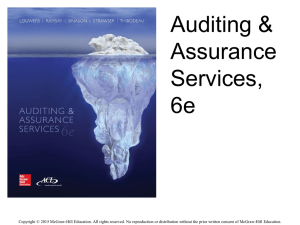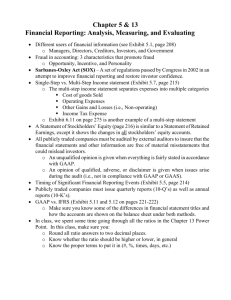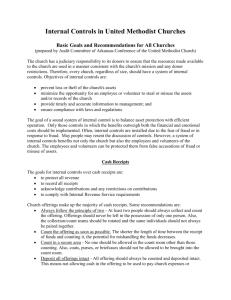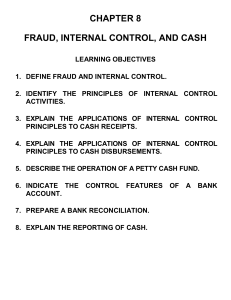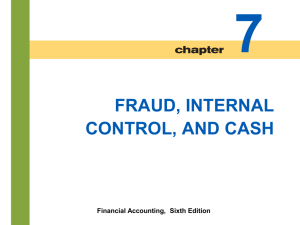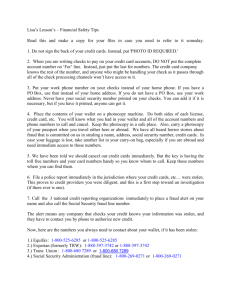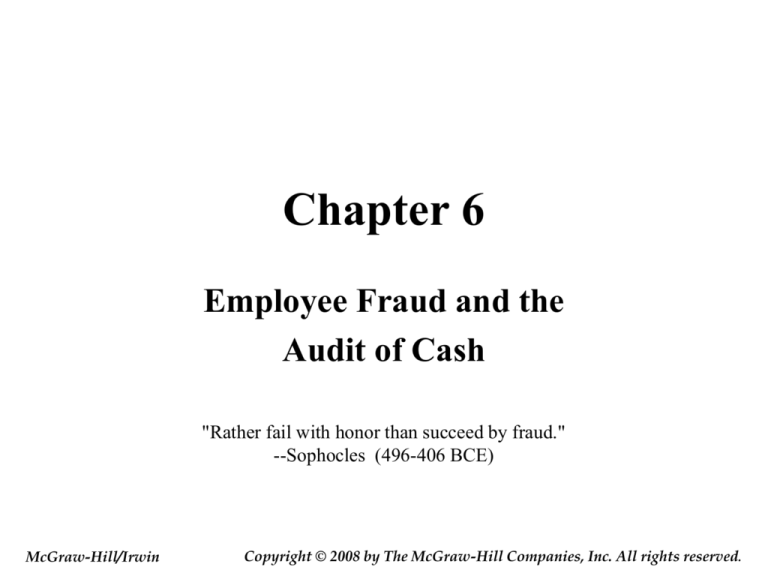
Chapter 6
Employee Fraud and the
Audit of Cash
"Rather fail with honor than succeed by fraud."
--Sophocles (496-406 BCE)
McGraw-Hill/Irwin
Copyright © 2008 by The McGraw-Hill Companies, Inc. All rights reserved.
6-2
Fraud Opportunities Revisited
6-3
Definitions Related to
Employee Fraud
• White collar crime is fraud perpetrated by people who work in offices
and steal with a pencil or a computer terminal. The contrast is violent
street crime.
• Employee fraud is the use of fraudulent means to take money or other
property from an employer. It consists of three phases: (1) the
fraudulent act, (2) the conversion of the money or property to the
fraudster's use and (3) the cover-up.
• Embezzlement is a type of fraud involving employees' or
nonemployees' wrongfully taking money or property entrusted to their
care, custody, and control, often accompanied by false accounting
entries and other forms of lying and cover-up.
• Larceny is simple theft of an employers property that is not entrusted
to an employee's care, custody or control.
• Defalcation is another name for employee fraud and embezzlement.
6-4
Exhibit 6-1
Fraud Elements
Motivation
Opportunity
Rationalization
High
Risk
Source: W.Hillison, D. Sinason, and C. Pacini, “The Role of the Internal Auditor in Implementing SAS 82,”
Corporate Controller, July/August 1998, page 20.
6-5
Motive
• A motive is some kind of pressure a person
experiences and believes unshareable with friends
and confidants
– Actual or perceived need for money (Economic motive)
– “Habitual criminal” who steals for the sake of stealing
(Psychotic motive)
– Committing fraud for personal prestige (Egocentric
motive)
– Cause is morally superior, justified in making others
victims (Ideological motive)
6-6
Opportunity
• An opportunity is an open door for solving
the unshareable problem by violating a
trust.
– Weak internal controls
– Circumvention of internal controls
– The greater the position, the greater the trust
and exposure to unprotected assets.
6-7
Rationalization
• When people do things that are contrary to their personal
beliefs – outside their normal behavior – they provide an
argument to make the action seem like it is in line with
their moral and ethical beliefs.
– Some of the most frequent rationalizations are:
•
•
•
•
•
•
•
I need it more than the other person.
I’m borrowing the money and will pay it back.
Everybody does it.
The company is big and will never miss it.
Nobody will get hurt.
I am underpaid, so this is due compensation
I need to maintain a lifestyle and image.
6-8
Red Flags: Employee Fraud
o
o
o
o
o
o
o
Missing documents.
Alterations on documents.
Photocopied documents.
Second endorsements on checks.
Unusual endorsements.
Old outstanding checks.
Unexplained adjustments to
accounts receivable and
inventory balances.
o Unusual patterns in deposits in
transit.
o General ledgers that do not
balance.
o Cash shortages and overages.
o Excessive voids and credit
memos.
o Customer complaints.
o Common names or addresses for
refunds.
o Increased past due receivables.
o Inventory shortages.
o Increased scrap.
o Duplicate payments.
o Employees that cannot be found.
o Dormant accounts that have
become active.
6-9
Fraud Prevention
• Managing people pressures in the
workplace
– Counseling services
– Hotlines
• Control procedures and employee
monitoring
• Integrity by example and enforcement
6-10
Cash Collections and Disbursements
• Cash is highly liquid, easily transportable,
and not easily identifiable, and therefore is a
primary target for employee thieves.
• Some strong internal controls:
– Dual custody of cash at all times
– Lockbox arrangement
– Fidelity bonds
Exhibit 6.2
Processing Cash Receipts
6-11
6-12
Cash Collections: Typical Activities
• Receive cash and REMITTANCE ADVICE in mail.
• Prepare REMITTANCE LISTING.
• Enter total from REMITTANCE LISTING (or
REMITTANCE ADVICE) in CASH RECEIPTS
JOURNAL.
• Prepare DEPOSIT SLIP and deposit cash receipts in bank
(INTACT and DAILY).
• Record update to SUBSIDIARY ACCOUNTS
RECEIVABLE using REMITTANCE ADVICE.
• Reconcile REMITTANCE LISTING, SUBSIDIARY
ACCOUNTS RECEIVABLE , and DEPOSIT SLIP daily
Cash Collections and Disbursements:
Key Control Activities
6-13
• INFORMATION PROCESSING
– Voucher packet (Purchase requisition, purchase order, receiving report, invoice)
matched prior to cash disbursement authorization
– Deposits reconciled to amounts credited to accounts receivable ledger
– Bank reconciliation
• PHYSICAL CONTROLS OVER THE SECURITY OF ASSETS
–
–
–
–
–
–
Deposit cash and checks daily and intact
Lock box account
EDI transactions
Dual custody over cash
Unused checks secured
Check imprinting machine
• SEGREGATION OF DUTIES
– Separate custody, authorization, recording, execution
• PERFORMANCE REVIEWS
• RECONCILIATIONS
6-14
Cash Disbursements:
Control Risk Assessment
• Control considerations
–
–
–
–
Proper separation of duties
Detail control (error-checking) activities
Internal control questionnaires (ICQs)
Transaction process “walkthrough”
• Detail test of controls audit procedures
(Exhibit 6.4)
Exhibit 6.4
Tests of Controls Over Cash Disbursements
6-15
6-16
Audit Evidence in Management
Reports and Data Files
•
•
•
•
•
Cash receipts journal
Cash disbursements journal
Bank reconciliations
Cancelled checks
Bank statements
– The audit team will often request that a CUTOFF BANK
STATEMENT be sent directly to the auditor prior to subsequent
month-end in order to verify deposits-in-transit and cleared checks
on a timely basis.
6-17
Exhibit 6.5
How to Read a
Cancelled Check
and Endorsement
6-18
Exhibit 6.6
Small Business
Bank Statement
6-19
Audit of Cash
• Cash on hand
– Count SIMULTANEOUSLY with other liquid
assets
– Count in presence of client employee
– Undeposited receipts
• Trace to cash receipts journal (CRJ)
• Vouch to subsequent deposit in bank statement
• Cash on Deposit
– Audited mainly through the client’s BANK
RECONCILIATION.
6-20
Bank Reconciliation
•
Balance per bank
–
–
•
Add Deposits-in-transit
–
–
•
VOUCH to cash disbursements journal
TRACE checks cleared from cutoff bank statement
Add/Subtract Debit/Credit Memos
–
•
TRACE to cash receipts journal
VOUCH to CUTOFF BANK STATEMENT
Subtract Outstanding Checks
–
–
•
CONFIRM (STANDARD BANK CONFIRMATION) directly with bank
Agree to CUTOFF BANK STATEMENT
Inspect bank credit/debit memo
Balance per books
–
–
FOOT Reconciliation
TRACE to trial balance
Exhibit 6.7
Bank Reconciliation
6-21
6-22
Standard Bank Confirmation
• In addition to corroborating cash and loan balances, a
STANDARD BANK CONFIRMATION INQUIRY
also requests information about contingent liabilities
and secured transactions.
6-23
Exhibit 6.8
Bank
Confirmation
6-24
Check Kiting
• KITING is a fraud that occurs by reporting cash
simultaneously in two different bank accounts.
• A Schedule of Interbank Transfers (Exhibit 6-10)
is generally useful in detecting KITING.
Exhibit 6.9
Illustrative Check Kiting Transactions
6-25
Exhibit 6.10
Illustration of Interbank Transfer Schedule
6-26
6-27
Proof of Cash
• A PROOF OF CASH is used when controls over
cash are weak.
• It essentially combines two bank reconciliations,
reconciling all transactions that occurred during the
period to the client’s Cash Receipts Journal and Cash
Disbursements Journal.
Exhibit 6.11
Illustration of Proof of Cash—First National Bank
6-28
6-29
Fraud Detection Procedures for Cash
•
•
•
•
•
•
•
Count the petty cash twice in one day
Examine endorsements on canceled checks
Audit general journal entries
Retrieve customer checks
Use marked coins and currency
Measure deposit lag time
Examine documents (bank statements) for
alteration (See Exhibit 6.6)
• Inquiry, ask questions
• Covert surveillance

